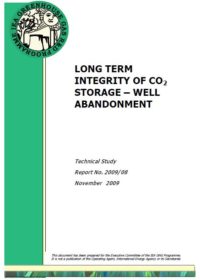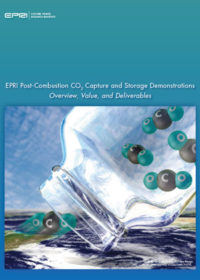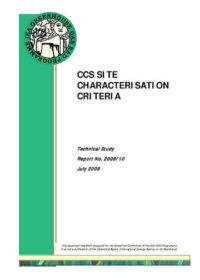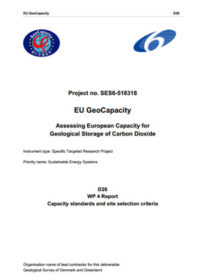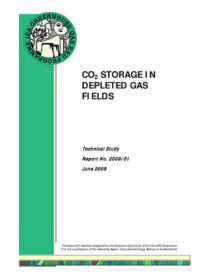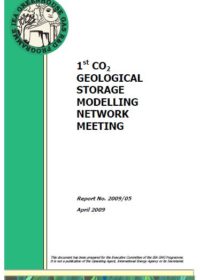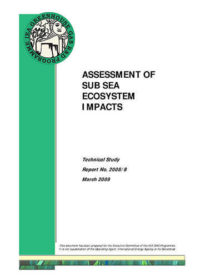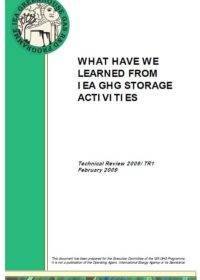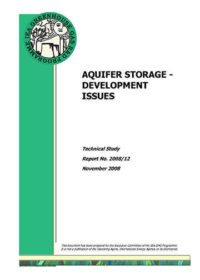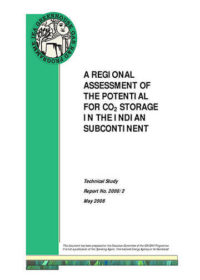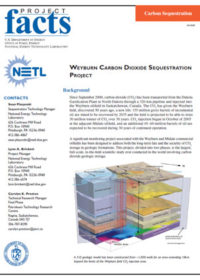Resources
Publications
Our publications, reports and research library hosts over 500 specialist reports and research papers on all topics associated with CCS.
View our Publication Library Disclaimer.
Filter by
Long term integrity of CO2 storage: well abandonment
1st November 2009
Topic(s): Carbon capture use and storage (CCUS), CO2 storage
The report includes a high-level review of the variety of techniques that are employed around the world to facilitate well abandonment. The report describes the preliminary work necessary, such as removal of equipment from the well and cleanout of the wellbore before plugging can take place. The report outlines the basic principles involved in each plugging method and highlights the drawbacks and limitations of the methods.
Disclaimer
The content within the Global CCS Institute Publications, Reports and Research Library is provided for information purposes only. We make every effort and take reasonable care to keep the content of this section up-to-date and error-free. However, we make no claim as to its accuracy, currency or reliability.
Content and material featured within this section of our website includes reports and research published by third parties. The content and material may include opinions and recommendations of third parties that do not reflect those held by the Global CCS Institute.
EPRI post-combustion CO2 capture and storage demonstrations: overview, value, and deliverables
1st October 2009
Topic(s): Carbon capture use and storage (CCUS), CO2 capture, CO2 storage
The Electric Power Research Institute, Inc. (EPRI) has examined options for reducing greenhouse gas (GHG) emissions from the electric sector. This publication details EPRI’s analysis, showing significant potential carbon dioxide (CO2) reduction from advanced coal power systems that include CO2 capture and storage (CCS) technology, making such systems likely to be an essential component of a full portfolio of GHG reductions strategies.
Disclaimer
The content within the Global CCS Institute Publications, Reports and Research Library is provided for information purposes only. We make every effort and take reasonable care to keep the content of this section up-to-date and error-free. However, we make no claim as to its accuracy, currency or reliability.
Content and material featured within this section of our website includes reports and research published by third parties. The content and material may include opinions and recommendations of third parties that do not reflect those held by the Global CCS Institute.
CCS site characterisation criteria
1st July 2009
Topic(s): Carbon capture use and storage (CCUS), CO2 storage
The IEA Greenhouse Gas R&D Programme (IEA GHG) has recently commissioned the Alberta Research Council in Canada to conduct a review of storage site selection criteria and site characterisation methods in order to produce a synthesis report. Among the various elements of the CO2 capture and storage (CCS) chain, the stage of storage site selection and characterisation is of critical importance because any storage site must demonstrate that it satisfies three fundamental requirements:
- capacity to store the intended volume of CO2 over the lifetime of the operation,
- injectivity, to accept/take CO2 at the rate that it is supplied from the emitter(s),
- containment, to ensure that CO2 will not migrate and/or leak out of the storage unit (safety and security of storage).
This report reviews the literature on the subject on site selection and characterisation since the publication of the IPCC Special Report on CCS, and provides a synthesis and classification of criteria.
Disclaimer
The content within the Global CCS Institute Publications, Reports and Research Library is provided for information purposes only. We make every effort and take reasonable care to keep the content of this section up-to-date and error-free. However, we make no claim as to its accuracy, currency or reliability.
Content and material featured within this section of our website includes reports and research published by third parties. The content and material may include opinions and recommendations of third parties that do not reflect those held by the Global CCS Institute.
Assessing European capacity for geological storage of carbon dioxide. D 26, WP 4 report: capacity standards and site selection criteria
16th June 2009
Topic(s): Carbon capture use and storage (CCUS), CO2 storage
The GeoCapacity project assesses European capacity for geological storage of CO2 in deep saline aquifers, oil and gas structures and coal beds. This publication reports on the site selection criteria required when considering sites for geological storage. It presents a site ranking methodology based on geological suitability for CO2 storage and on data availability and confidence.
Disclaimer
The content within the Global CCS Institute Publications, Reports and Research Library is provided for information purposes only. We make every effort and take reasonable care to keep the content of this section up-to-date and error-free. However, we make no claim as to its accuracy, currency or reliability.
Content and material featured within this section of our website includes reports and research published by third parties. The content and material may include opinions and recommendations of third parties that do not reflect those held by the Global CCS Institute.
CO2 storage in depleted gas fields
1st June 2009
Topic(s): Carbon capture use and storage (CCUS), CO2 storage
Three main CO2 geological storage scenarios may currently be considered as technologically-advanced – deep saline formations, depleted oil fields as part of enhanced oil recovery (EOR) schemes, and depleted natural gas fields. Much attention is currently focussed on deep saline formations due to these providing the largest theoretical global storage resource (10,000Gt according to the 2004 IPPC Special Report), and on CO2-EOR schemes due to the potential economic benefits. However, depleted gas fields offer significant advantages for CO2 storage: proven capacity and sealing structures to give confidence in storage security; and the presence of existing infrastructure that may be suitable for re-use in storage operations. Whilst some technical challenges remain – for example, controlling the flow of injected CO2 into de-pressurised formations where aquifer ingress is low or absent – storage in depleted gas fields could be regarded in some locations as an ‘early’ opportunity for large scale commercial storage. The southern North Sea provides an example of such a location, where a number of large fields are rapidly approaching exhaustion of recoverable natural gas reserves.
A key objective of this work is to advance the analysis undertaken in the IEA GHG report Barriers to overcome in implementation of CO2 capture and storage: Storage in disused oil and gas fields, which identified a total potential worldwide capacity of 923 Gt CO2, in depleted gas fields, of which 797 Gt is in depleted gas fields.
Disclaimer
The content within the Global CCS Institute Publications, Reports and Research Library is provided for information purposes only. We make every effort and take reasonable care to keep the content of this section up-to-date and error-free. However, we make no claim as to its accuracy, currency or reliability.
Content and material featured within this section of our website includes reports and research published by third parties. The content and material may include opinions and recommendations of third parties that do not reflect those held by the Global CCS Institute.
1st CO2 Geological Storage Modelling Network meeting
1st April 2009
Topic(s): Carbon capture use and storage (CCUS), CO2 storage
The concept of this workshop was previously proposed to the IEA Greenhouse Gas R&D Programme (IEA GHG) by BRGM and Schlumberger, and following the approval of the workshop in principle, discussion was initiated in June 2008 at the IEA GHG Joint Network Meeting in New York. The suggestion was that CO2 geological modelling for Carbon Dioxide Capture and Storage (CCS) was an important topic not being adequately dealt with by the existing storage based research networks. Further discussions by these network groups concluded that this was indeed a gap, and that an initial workshop should be held to determine the viability of forming a separate network dealing solely with geological storage modelling.
Disclaimer
The content within the Global CCS Institute Publications, Reports and Research Library is provided for information purposes only. We make every effort and take reasonable care to keep the content of this section up-to-date and error-free. However, we make no claim as to its accuracy, currency or reliability.
Content and material featured within this section of our website includes reports and research published by third parties. The content and material may include opinions and recommendations of third parties that do not reflect those held by the Global CCS Institute.
Assessment of sub sea ecosystem impacts
1st March 2009
Topic(s): Carbon capture use and storage (CCUS), CO2 storage
One of the key elements required before receiving permission to commence underground storage of CO2, will be the ability of the operator to predict the behaviour of the injected CO2 and demonstrate a thorough understanding of the risks of leakage, and the associated impacts of these leaks. Also, CO2 Capture and Storage (CCS) operators must be able to demonstrate that CO2 can be injected into suitable storage reservoirs both safely and with minimal or no environmental impact. The safety aspect predominantly relates to good design and operational practices and strict adherence to accepted health and safety procedures.
This study aims to assess the extent of information currently available on the effects of CO2 seepage on subsea ecosystems, and assess what gaps in knowledge exist, along with providing recommendations for further research to address these gaps.
Disclaimer
The content within the Global CCS Institute Publications, Reports and Research Library is provided for information purposes only. We make every effort and take reasonable care to keep the content of this section up-to-date and error-free. However, we make no claim as to its accuracy, currency or reliability.
Content and material featured within this section of our website includes reports and research published by third parties. The content and material may include opinions and recommendations of third parties that do not reflect those held by the Global CCS Institute.
What have we learned from IEA GHG storage activities
1st February 2009
Topic(s): Carbon capture use and storage (CCUS), CO2 storage
This report is intended to provide a summary of key learning points from recent IEA Greenhouse Gas R&D Programme (IEA GHG) activities related to the geological storage of CO2.
The report summarises key learning points from IEA GHG operating Phase 5, which commenced in 2005 and effectively coincided with the publication of the IPCC Special Report on Carbon Dioxide Capture and Storage (IPCC SRCCS). That publication provides a useful reference point for the subsequent knowledge on storage acquired through IEA GHG activities.
Disclaimer
The content within the Global CCS Institute Publications, Reports and Research Library is provided for information purposes only. We make every effort and take reasonable care to keep the content of this section up-to-date and error-free. However, we make no claim as to its accuracy, currency or reliability.
Content and material featured within this section of our website includes reports and research published by third parties. The content and material may include opinions and recommendations of third parties that do not reflect those held by the Global CCS Institute.
Aquifer storage: development issues
1st November 2008
Topic(s): Carbon capture use and storage (CCUS), CO2 storage
Earlier studies by IEA GHG had shown that of the main geological storage reservoirs available globally for CO2 storage, deep saline aquifers have the highest storage potential and substantial cuts in CO2 emissions may therefore require utilisation of deep saline aquifers as storage reservoirs. However, the storage capacity of deep saline aquifers from various estimates show wide bounds: from 1,000 to over 10,000 GtCO2 globally. Many of the deep saline aquifers being considered for storage are ‘virgin’ formations and structures in which little or no geological characterisation has taken place, in contrast to many oil and gas fields. Therefore, considerable exploratory work will be required before such structures can be considered as “fit for purpose” for CO2 storage. Selection of safe and secure geological reservoirs must be accompanied by confidence in the associated CO2 storage capacities.
The aim of this study was to bring together and review the research that has been undertaken in Europe, North America, Japan and Australia, to develop an understanding of how knowledge on deep saline aquifers has developed in recent years, in particular since the 2005 IPCC Special Report on CO2 Capture and Storage (IPCC SRCCS). Emphasis was placed on the identification of knowledge gaps and priority areas for R&D activities.
Disclaimer
The content within the Global CCS Institute Publications, Reports and Research Library is provided for information purposes only. We make every effort and take reasonable care to keep the content of this section up-to-date and error-free. However, we make no claim as to its accuracy, currency or reliability.
Content and material featured within this section of our website includes reports and research published by third parties. The content and material may include opinions and recommendations of third parties that do not reflect those held by the Global CCS Institute.
A regional assessment of the potential for CO2 storage in the Indian subcontinent
12th May 2008
Topic(s): Carbon capture use and storage (CCUS), CO2 storage
The IEA Greenhouse Gas R&D Programme (IEA GHG) has recently commissioned the British Geological Society (BGS) to conduct a regional assessment of the Indian subcontinent in order to gauge the potential for CO2 storage in geological reservoirs in that region. This is the 3rd regional capacity study conducted by the IEA GHG following on from assessments of Europe and North America. It should be noted that the study only assessed the four main options of geological storage; deep saline aquifers, depleted oil and gas fields, and storage in deep unminable coal fields. In addition, the study has undertaken an assessment of the current large point source emissions from the power sector on the Indian subcontinent and assessed their geographical relationship with possible geological stores. This process is also known as sourcestore matching, and a good source of CO2 close to suitable geological storage reservoirs can significantly impact on the costs and technical feasibility of a CCS operation. Without nearby sources for injection, the transport element of the CO2 chain becomes more expensive, and thus can result in the classification of a proposal as uneconomical.
The choice of the Indian subcontinent for this third study is primarily down to two main reasons. Firstly, as an emergent economy, India is considered likely to experience high growth in energy demand due to increasing economic development, and this will naturally include a corresponding increase in anthropogenic CO2 emissions. Much of the increased power demand will come from increased use of fossil fuels and in particular coal. The growth in energy demand is likely to be met by government backed plans to install increased capacity in power plants throughout many regions. History has taught us that when a country undergoes rapid economic growth, there is a corresponding increase in the demand for power and subsequent increase in anthropogenic CO2 emissions. The second driver behind the choice the Indian subcontinent is the current lack of any other definitive study into the capacity for CCS in the area.
Disclaimer
The content within the Global CCS Institute Publications, Reports and Research Library is provided for information purposes only. We make every effort and take reasonable care to keep the content of this section up-to-date and error-free. However, we make no claim as to its accuracy, currency or reliability.
Content and material featured within this section of our website includes reports and research published by third parties. The content and material may include opinions and recommendations of third parties that do not reflect those held by the Global CCS Institute.
The economics of geological CO2 storage and leakage
4th April 2008
Topic(s): CO2 storage, Economics, Engineering and project delivery
The economics of CO2 capture and storage in relation to the possibility of significant leakage of CO2 from geological reservoirs once this greenhouse gas has been stored artificially underground will be among the main determinants of whether CCS can significantly contribute to a deep cut in global CO2 emissions. This paper presents an analysis of the economic and climatic implications of the large-scale use of CCS for reaching a stringent climate change control target, when geological CO2 leakage is accounted for. The natural scientific uncertainties regarding the rates of possible leakage of CO2 from geological reservoirs are likely to remain large for a long time to come. We present a qualitative description, a concise analytical inspection, as well as a more detailed integrated assessment model, proffering insight into the economics of geological CO2 storage and leakage. Our model represents three main CO2 emission reduction options: energy savings, a carbon to non-carbon energy transition and the use of CCS. We find CCS to remain a valuable option even with CO2 leakage of a few %/yr, well above the maximum seepage rates that we think are likely from a geo-scientific point of view.
Disclaimer
The content within the Global CCS Institute Publications, Reports and Research Library is provided for information purposes only. We make every effort and take reasonable care to keep the content of this section up-to-date and error-free. However, we make no claim as to its accuracy, currency or reliability.
Content and material featured within this section of our website includes reports and research published by third parties. The content and material may include opinions and recommendations of third parties that do not reflect those held by the Global CCS Institute.
Weyburn Carbon Dioxide Sequestration Project
1st April 2008
Topic(s): Carbon capture use and storage (CCUS), CO2 storage
This National Energy Technology Laboratory Fact Sheet provides an overview of the Weyburn Carbon Dioxide Sequestration Project in Saskatchewan, Canada.
Disclaimer
The content within the Global CCS Institute Publications, Reports and Research Library is provided for information purposes only. We make every effort and take reasonable care to keep the content of this section up-to-date and error-free. However, we make no claim as to its accuracy, currency or reliability.
Content and material featured within this section of our website includes reports and research published by third parties. The content and material may include opinions and recommendations of third parties that do not reflect those held by the Global CCS Institute.
